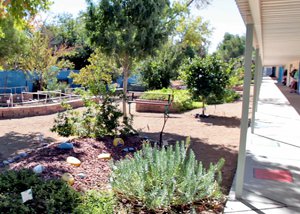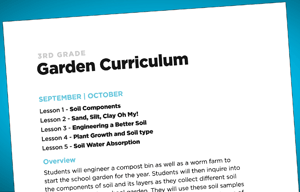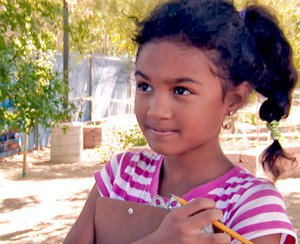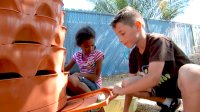Standards-Based Learning in a Garden
Flower and vegetable beds around school can serve as a multidisciplinary classroom.
Overview
Walter Bracken STEAM Academy, a Title I elementary magnet school in urban Las Vegas, Nevada, transformed 32,000 square feet of dry grass into student-centered learning gardens.
There are over 30 grade-specific garden beds throughout the school. Each grade has a distinct role:
- First-grade students plant seeds.
- Second-grade students get rid of harmful bugs.
- Third-grade students compost.
- Fourth-grade students run the farmers’ market.
- Fifth-grade students are in charge of recycling.

Through the Farm-preneuer Program, which is connected to Walter Bracken’s STEAM curriculum, fourth-grade students learn how to create a business from their vegetable gardens. Within a 12-week period of running the farmers’ market, they learn how to write a business plan, create profit-and-loss sheets, and run advertising campaigns.
"Initially, I just wanted my students to know that vegetables don't come from the grocery store," says Katie Decker, Walter Bracken's principal. “They come from the soil, from the ground, they grow, and it's a process. We built our first garden over in first grade, taking out a space where people dumped furniture, and we just slowly changed one area at a time each year."
How It's Done
Step 1: Gain Teacher Buy-In
"You have to have a vision and purpose that people are going to buy into," says Anna Hurst, Walter Bracken's assistant principal.
To gain teacher buy-in, Decker and Hurst recommend:
- You need a dream. Visiting schools that have successfully implemented a garden program will help you to visualize that dream.
- Describe your vision to teachers using research and mentioning community partners who will support them.
- Understand that it takes time.
Step 2: Create a Garden Team
Walter Bracken STEAM Academy has a garden team that includes a teacher from each grade level. "The gardening team is the engine that drives the program," says Ciara Byrne, the co-CEO of Green Our Planet, a nonprofit and Walter Bracken partner that helps schools build outdoor garden programs.
Each team member has a specific role, such as events coordinator, fundraiser, and garden team leader. A garden team:
- Runs the garden program, and shares decisions with teachers schoolwide
- Consists of at least one teacher from each grade level
- Could also include a parent from the PTA, as well as students at the high school level
- Meets once a month
- Ensures program sustainability
"When only one teacher is in charge of a program, you do not have sustainability," says Decker. With a garden team, if one teacher leaves, a replacement can be found.
Step 3: Fund Your Garden Program
To get started, Byrne recommends raising a minimum of $5,000 in order to "build a decent-sized garden, including raised beds, organic soil, proper irrigation, a shed (ideal, but not necessary), and curriculum to teach in the garden." The amount of money needed depends on the size and type of garden, whether volunteers help build it, and how much of your materials are donated.
Walter Bracken created its first garden bed for $1,000. They got some of the materials as donations or at a discounted rate, and students, staff, parents, and community volunteers did all the labor. The school staff also engineered the gardens themselves. "We start by looking at the space, and then engineer a design," says Decker. She suggests looking at other school gardens for inspiration. On Google Images, you can find a variety of ideas, from fairy gardens to circular beds and planters made with Lego bricks.
Organize Fundraisers
Walter Bracken typically raises $20,000 a year through fundraisers, such as:
- A carnival ($2,000)
- A color run ($2,000)
- A movie night ($500)
- An art auction ($500)
- A farmers' market ($200)
- A crowdfunding campaign ($14,466)
Partner With Donors
Walter Bracken also receives donations and grants from the Las Vegas Rotary Club and Capital One. Over the past six years, they’ve received $50,000 annually from a partnership with the Lanni Family Charitable Foundation.
When searching for donors, Decker recommends:
- Connect with the right partner for the right job. Her school asked a tech company to help them with coding, not gardening.
- Be specific when asking for what you need. You should have a clear vision and be able to describe how it specifically benefits your students.
- Introduce yourself, your school, and your ask in-person, and leave them with a letter describing what you want.
"Building relationships is the key to partnerships," advises Decker. Once you have a donor, she suggests communicating with them often. Let them know about the impact they are making, and thank them. Make them feel appreciated. Have your students write them thank you notes. "Thank them on your Facebook page and website," adds Decker.
Step 4: Partner With Garden Experts
Walter Bracken partners with Green Farms. This group’s farmers:
- Inform teachers weekly about what, when, and how to plant so that teachers can incorporate maintenance into their lessons
- Give weekly workshops
- Solve problems as they arise, such as fixing a stink bug infestation
- Maintain the gardens during the summer
- Prevent staff burnout
"You will burn out your staff if you don't provide assistance," cautions Decker. “Fundraise to build your garden account, and then as you build the art auctions and farmers’ markets, you will sustain the ability to pay for it.”
If you can't afford to hire a farming company, Byrne recommends partnering with a master gardener. Master gardeners need to volunteer 20 hours a year to maintain their status, and master gardener interns need to volunteer a minimum of 40 hours. Most state universities have cooperative extensions, which can connect you to master gardeners.
Step 5: Develop Your Garden Curriculum
Elaine Bennett, a Walter Bracken third-grade teacher, was part of a statewide team of teachers and farmers from Green Farms who developed the K-5 garden curriculum, which was organized and funded by Green Our Planet. Green Our Planet's garden curriculum includes significant portions of the Nevada State Standards and Next Generation Science Standards, and they sell their curriculum by grade level at a very reasonable price.

This curriculum was modeled after Walter Bracken's existing garden curriculum, which Bennett also helped develop. The school created a garden committee, which included a teacher from each grade level. They planned before school, after school, and during their grade-level professional learning community. "Each grade level looked at the curriculum and created lessons which they could use in the gardens," explains Bennett. “They then brought them back to the committee to collaborate and plan across grade levels.”
When developing your curriculum, Bennett advises:
- Start with the content that your students need to learn and the teaching resources that you have available.
- Review existing curriculum and adapt it to your needs.
- Meet by grade levels, and start creating one lesson at a time.
- Search the internet for example garden lessons.
- Discuss issues with your team as they occur, and problem solve as a group.
- Ask for help from someone who knows about gardening. (Initially, a Walter Bracken parent helped them get started.)
Whether you're working with a parent, a master gardener, or a farmer, these are some helpful questions to ask:
- What could be planted and when?
- How does the climate impact planting?
- What containers work best?
- What watering schedules should you follow?
- What soil should you use?
- When and how should you harvest?
- How do you collect seeds?
- How do you manage insect and pest control?
Step 6: Incorporate the Garden Into Your Lessons
Every grade level is responsible for maintaining its own garden. Walter Bracken teachers use "What's growing in the garden" sheets (PDF) to help students learn more about the plants under their care. "We typically do a garden lesson at least two to three times a month," says Roshelle Barrow, a Walter Bracken third-grade teacher. "But students are in the gardens every day. Sometimes it's just a ten-minute activity where they're maintaining it.”

"I check to see if the soil is moist by dipping my finger in. The last thing I have to do is turn the compost bins around," explains Alana, a Walter Bracken third-grade student. Each student gets a garden checklist (PDF). It specifies the garden bed where they work and includes a space for their name, the date, and assigned maintenance activities. "I get to see if there are any problems, and if there are, I check off yes, and then write them down. I think one day I may have a garden of my own," adds Alana.
